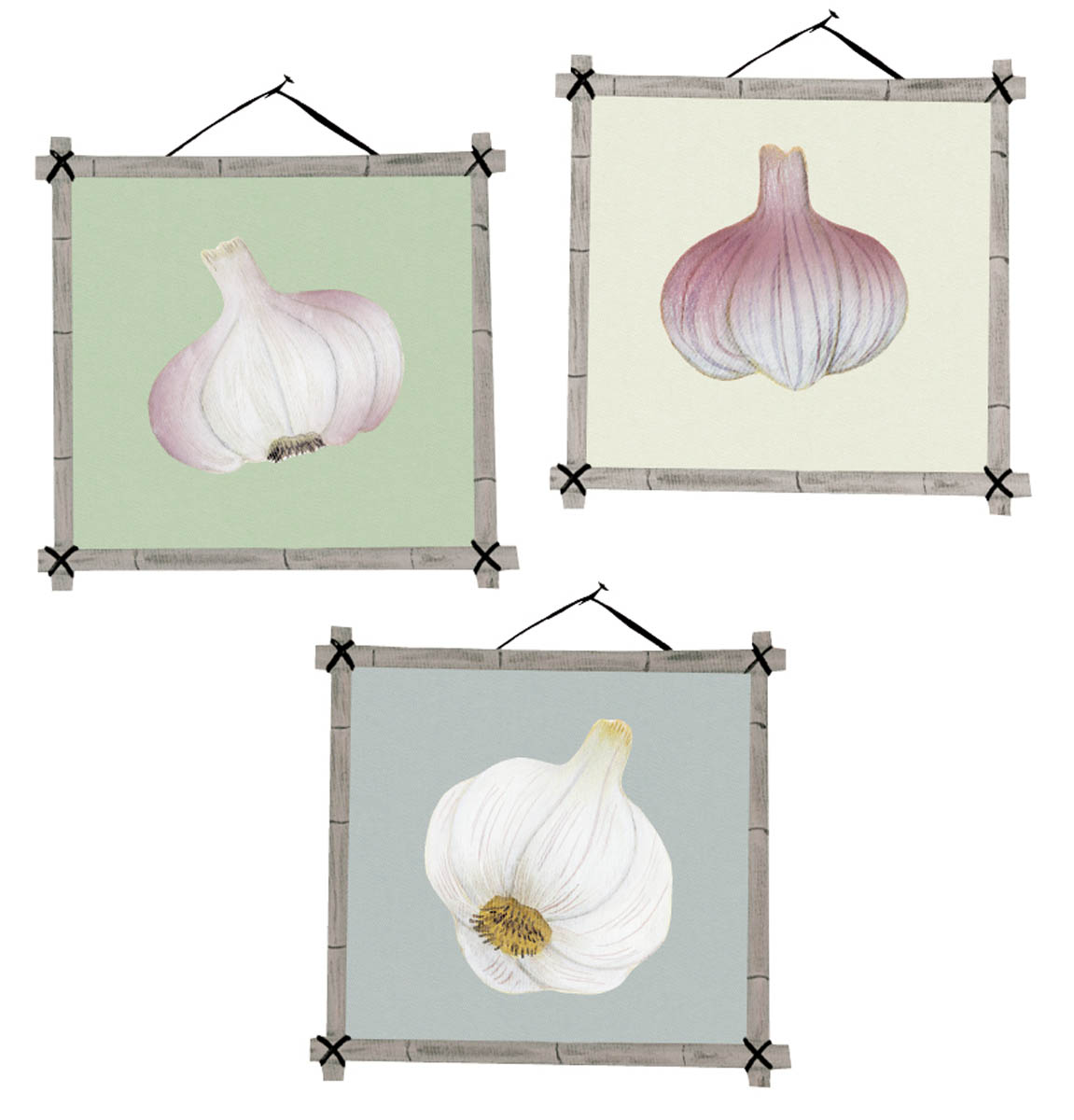
Liz Primeau’s small garden showcases the range of flavors found among the many varieties of garlic. One of the easiest crops to grow, garlic demands little in the way of maintenance and is virtually pest- and disease-free. Even deer tend to ignore this vegetable! Between her tidy rows of garlic, Liz has added clumps of low-growing thyme, hens and chicks, and creeping Jenny to create a colorful carpet and suppress weed growth.
Any serious cook will tell you that garlic is an essential ingredient in the kitchen. There is nothing quite like the flavor of homegrown garlic, which is fresher, richer, and more aromatic than anything you can buy at the supermarket. As Liz’s plan demonstrates, you don’t need a huge site to grow good garlic. Just be sure to find a spot with decent soil and at least 6 hours of sun, so your plants produce the largest bulbs possible.

These three groups of minor hardnecks may produce a minimal scape, sometimes appearing as softneck.
Hardy hardneck. In the north, hardneck garlic is the predominant type and is valued for its hardiness and cold resistance. The cloves of this type are arranged around a central flower stalk or scape that emerges in early summer; typically it’s removed so the plant’s energy is directed toward producing large bulbs and not flowers. Many gardeners consider the scapes a gourmet treat, turning them into gourmet pestos or chopping and sprinkling them into quiches, scrambled eggs, or pastas. Hardneck garlic needs to be planted “pointy side up” and so is reserved for small-scale farming operations and backyards.
Plain hardneck garlic is divided into three true groups that produce a flower scape:
Braidable softneck. Softneck garlic is favored in milder climates and if grown in cold regions may bolt in spring, diminishing the eventual size of the bulb. Unlike hardneck garlic, softneck types don’t typically produce a hard central stalk, so they are easier to plait into decorative braids. Softneck garlic can also be mechanically planted and is therefore the predominant type found at supermarkets.
Plain softneck garlic is divided into two main groups:
The setting. Inspired by Liz’s actual garlic garden, this compact plan combines some of her favorite varieties — one softneck and seven hardneck — in a very ornamental setting. Liz has tucked the garlic garden into the middle of her extensive perennial garden, but it could also be sited off a deck or near a back door, where it’s only a short stroll from the kitchen to the garlic patch.
Storing the stink. More or fewer garlic plants or varieties could be grown, depending on one’s garlic needs. “This garden gives me enough garlic to keep me ’til just before Christmas,” she says. Hardneck garlic, once cured and property stored, will keep for about six months. Softneck garlic, on the other hand, will keep up to a year when stored in a cool, ventilated room with a temperature between 60 and 65°F (15 to 18°C). The eight varieties shown here were chosen for their various flavors that range from mild to strong.
Between each row of garlic, Liz has planted a narrow strip of a low-growing perennial, either creeping Jenny, various thymes, or hens and chicks. These add bright color to the garden, entice pollinators, and also create a living mulch to keep weeds at bay. Liz chose to include compact perennials between her garlic rows because they don’t cast shade on the all-important garlic plants, which have few leaves and need all of the sun they can get.
It’s a big garlic world. Liz admits that her garlic choices vary from year to year, and that as a garlic lover she enjoys experimenting with new varieties in her garden. She often finds them at garlic festivals and fairs across North America and Europe. “All of these varieties are pretty strong in flavor, except for the famed ‘Rose de Lautrec’, which is milder and earthier than the others,” she notes. “There are nuances in flavor, but all of the varieties still have that distinctive garlic taste.”

1. ‘Music’. A high-producing, mild Porcelain type with white skins blushed in pink. The big cloves are easy to peel, and the bulbs will store for about nine months. This garden favorite is widely available.
2. ‘Spanish Roja’. This heirloom Rocambole type is a standout in northern gardens with a flavor often described as “true garlic.” The bulbs have purplish brown skins and will store for six to nine months.
3. ‘Rose de Lautrec’. Most likely a Creole type, ‘Rose de Lautrec’ is the signature ingredient in the classic French soup Soup a l’Ail Rose de Lautrec. The bulbs have a mild and earthy flavor. This rare variety is prized among garlic lovers.
4. ‘Russian Red’. A Rocambole garlic, ‘Russian Red’ has a rich, garlicky flavor and easy-to-peel cloves. This is an excellent table garlic and each bulb will yield six to eight cloves.
5. ‘Chesnok Red’. This is a Purple Stripe type that originally hails from Georgia in the former USSR. It gets its name from the striking bulbs whose white papery skin is striped in purple. The flavor is commonly described as “bold,” and the bulbs will store for up to six months.
6. ‘Majestic’. This Porcelain type produces strong plants with good-size bulbs. Expect to harvest 4 to 5 large cloves per bulb, covered with a satiny white wrapper.
7. ‘Lorz Italian’. This is a softneck heirloom garlic that was brought to the United States from Italy in the middle of the nineteenth century. The large cloves have a strong, bold flavor and form sizable heads. The plants adapt easily to hot summers.
8. ‘Rosewood’. This is another Porcelain garlic with a mild flavor that is rich but not overwhelming. The plump cloves are easy to peel, with 4 to 5 per bulb.